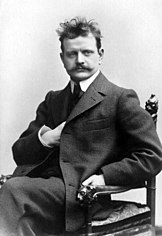The Finnish composer Jean Sibelius (1865–1957) was one of the most important symphonists of the early twentieth century: his seven symphonies, written between 1899 and 1924, are the core of his oeuvre and stalwarts of the standard concert repertoire.[1] Many of classical music's conductor–orchestra partnerships have recorded the complete set, colloquially known as the "Sibelius cycle".[2] Specifically, the standard cycle includes:
- Symphony No. 1 in E minor,[a] Op. 39 (1899; minor revisions 1900)
- Symphony No. 2 in D major,[b] Op. 43 (1902)
- Symphony No. 3 in C major,[c] Op. 52 (1907)
- Symphony No. 4 in A minor,[d] Op. 63 (1911)
- Symphony No. 5 in E-flat major,[e] Op. 82 (1915; major revisions 1916 and 1919)
- Symphony No. 6 in D minor,[f] Op. 104 (1923)
- Symphony No. 7 in C major,[g] Op. 105 (1924)
Although early advocates such as Robert Kajanus, Sir Thomas Beecham, and Serge Koussevitzky had conducted many of Sibelius's symphonies for gramophone in the 1930s and 1940s, none of these Sibelians recorded all seven.[19] Instead, the earliest complete traversal dates to 1953, four years before the composer's death on 20 September 1957; it is by Sixten Ehrling and the Stockholm Radio Orchestra, recorded from 1952–1953 for the Swedish label Metronome Records (released by Mercury Records in the United States). Ehrling had outpaced Anthony Collins and the London Symphony Orchestra, whose cycle—recorded from 1952–1955 on Decca Records—was concurrent with Ehrling's but arrived second.[2]
Since the pioneering examples of Ehrling and Collins, the Sibelius cycle has, as of September 2022[update], been recorded an additional 46 times. The most recently completed (48th) cycle, finished in 2022, is by Owain Arwel Hughes and the Royal Philharmonic Orchestra; an additional two projected cycles are in progress, according to press releases. A number of conductors have tackled the project more than once: Paavo Berglund (1977, 1987, 1997, 1998) recorded the Sibelius cycle four times, Sir Colin Davis (1976, 1994, 2008) three times, and Akeo Watanabe (1962, 1981), Lorin Maazel (1968, 1992), Jukka-Pekka Saraste (1989, 1993), Leif Segerstam (1992, 2004), Neemi Järvi (1985, 2005), Vladimir Ashkenazy (1984, 2007), Pietari Inkinen (2009, 2013), Sir Simon Rattle (1987, 2015), and Osmo Vänskä (1997, 2015) have done so twice. Leonard Bernstein completed one cycle (1967) but died in the middle of a second. Finally, Herbert von Karajan and Eugene Ormandy left, respectively, three and two incomplete Sibelius cycles.
Additionally, the Sibelius cycle can, in its non-standard form, include its "grand precursor"[20] Kullervo (Op. 7, 1892), which some commentators view as a programmatic choral symphony.[21] This perspective conceptualizes Kullervo as Sibelius's de facto "Symphony No. 0",[22] thus expanding his completed contributions to the symphonic canon from seven to eight. Eleven of the 48 cycles include Kullervo as a supplement.
- ^ Abraham 1947, p. 14; Downes 1956, p. 5; Ewen 1967, p. 573; Rickards 1997, pp. 197–201; Smith 2002, p. 68; Barnett 2007, p. 353.
- ^ a b Layton 2001, p. 22.
- ^ Tawaststjerna 1976, p. 208.
- ^ Barnett 2007, p. 124.
- ^ Tawaststjerna 1976, p. 243.
- ^ Barnett 2007, pp. 146–147.
- ^ Tawaststjerna 1986, p. 66.
- ^ Barnett 2007, p. 182.
- ^ Tawaststjerna 1986, p. 169.
- ^ Barnett 2007, p. 210.
- ^ Tawaststjerna 1997, pp. 69–70.
- ^ Barnett 2007, p. 255.
- ^ Tawaststjerna 1997, p. 162.
- ^ Barnett 2007, p. 284.
- ^ Tawaststjerna 1997, pp. 226–227.
- ^ Barnett 2007, p. 299.
- ^ Tawaststjerna 1997, p. 245.
- ^ Barnett 2007, pp. 307–308.
- ^ Layton 2001, pp. 14–22.
- ^ Steinberg 1995, p. 607.
- ^ Tawaststjerna 1976, pp. 107–108; de Gorog 1989, p. 45; Steinberg 1995, pp. 574–575; Rickards 1997, p. 48; Smith 2002, pp. 62, 83; Hurwitz 2007, pp. 51, 57.
- ^ Breitkopf & Härtel 2005, PB 5304 study score.
Cite error: There are <ref group=lower-alpha> tags or {{efn}} templates on this page, but the references will not show without a {{reflist|group=lower-alpha}} template or {{notelist}} template (see the help page).


